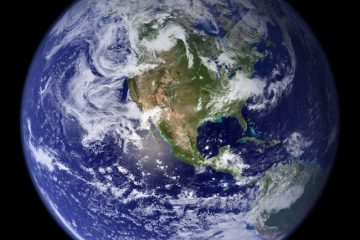Table of Contents
- Exploring the Foundations of the Gaia Hypothesis
- Understanding the Impact of James Lovelocks Work
- Interconnectedness of Life and Earth: A Deeper Look
- Practical Applications of the Gaia Hypothesis Today
- Recommendations for Further Reading and Exploration
- Q&A
- The Conclusion

Exploring the Foundations of the Gaia Hypothesis
The Gaia Hypothesis, proposed by scientist James Lovelock in the 1970s, fundamentally challenges our understanding of Earth’s ecological balance. At its core, the hypothesis posits that the Earth can be viewed as a single, self-regulating system where the biological components interact with the physical environment to maintain conditions favorable for life. This integration suggests that various life forms, from the tiniest microbes to large mammals, collaborate in regulating the planet’s atmosphere, temperature, and even the pH of the oceans.
Key components of this theory include:
- Interconnectedness: Life affects geological and chemical processes.
- Self-regulation: Organisms contribute to a balance that sustains life.
- Long-term stability: Evolution and ecological changes create a stable environment over geological time scales.
Lovelock’s hypothesis not only revolutionizes scientific thought but also touches on philosophical questions about humanity’s role in nature. It encourages a shift in perspective, viewing our planet not merely as a resource to be exploited but as a complex living system in which humans are just one part. By understanding these connections, we can better appreciate the critical balance necessary for sustaining life and the importance of nurturing our environment for future generations.
Understanding the Impact of James Lovelocks Work
James Lovelock’s work, particularly his formulation of the Gaia hypothesis, has profoundly influenced our understanding of Earth as a complex, self-regulating system. The hypothesis posits that the Earth’s biological and physical components are interconnected, functioning together to maintain conditions conducive to life. This perspective shifts the focus from viewing humans as separate from nature to recognizing our integral role within the Earth’s systems. By fostering a holistic view of ecology, Lovelock encourages a deeper appreciation of biodiversity and the delicate balance of our planetary systems.
One of the pivotal aspects of Lovelock’s research is its emphasis on feedback loops in the environment. The Gaia hypothesis outlines how various elements, such as atmosphere, oceans, and living organisms, interact dynamically to sustain life. For example, plants regulate atmospheric carbon dioxide, which in turn affects climate. The interdependencies highlighted in this framework challenge traditional scientific approaches that often isolate variables. Through Lovelock’s lens, we are reminded of the necessity for interdisciplinary collaboration in fields such as climate science, conservation, and environmental policy.
Moreover, Lovelock’s insights have sparked critical discussions about human impact on the planet. His work serves as a cautionary tale regarding environmental degradation and climate change. Early warnings embedded in the Gaia hypothesis advocate for sustainable practices and proactive stewardship of the Earth. As awareness grows around these issues, Lovelock’s teachings have inspired movements dedicated to ecological balance, culminating in actionable strategies and policies aimed at ensuring a sustainable future. The lasting legacy of his work is an urgent call to recognize our responsibilities as stewards of the Earth.

Interconnectedness of Life and Earth: A Deeper Look
The intricate relationship between life and the Earth is a captivating tapestry woven from countless threads of interaction. The essence of the Gaia Hypothesis posits that the biosphere and the inorganic components of the Earth function collectively as a self-regulating system. This synergistic relationship encompasses various elements, creating a vibrant ecosystem, where each component plays a vital role in maintaining balance:
- Biological Interactions: Plants, animals, and microorganisms contribute to nutrient cycling and energy flow, fostering an environment conducive to life.
- Atmospheric Influence: Living organisms affect the atmosphere, with processes like photosynthesis and respiration regulating gas concentrations vital for survival.
- Soil Health: The continuous interaction between flora and fauna enriches soil quality, promoting diversity and resilience across ecosystems.
This self-regulating nature showcases how interconnected our world truly is. As organisms evolve and adapt in response to environmental changes, they also influence these very changes, creating a feedback loop essential for sustaining life. For instance, consider how coral reefs act as a barrier that protects shorelines while simultaneously providing habitats for a multitude of marine species. Such relationships emphasize the need for a holistic understanding of Earth’s systems, urging us to consider the long-term impacts of our actions on this delicate balance:
| Earth System Components | Role in Interconnectedness |
|---|---|
| Atmosphere | Regulates temperature and gas composition, sustaining life. |
| Hydrosphere | Water cycles support life and climatic patterns. |
| Lithosphere | Provides minerals and nutrients essential for growth. |
| Biosphere | Hosts diverse life forms and their interactions. |
As we dive deeper into the Gaia Hypothesis, we uncover more about how human activity disrupts this intricate web. Pollution, habitat destruction, and climate change intensify the vulnerabilities embedded within these interconnected systems. Understanding the profound impact of our actions on Earth’s systems is essential for fostering a sustainable future. By embracing this awareness, we can begin to adopt practices that align with the natural rhythms of our planet, ensuring a balanced coexistence with the myriad forms of life that share our home.

Practical Applications of the Gaia Hypothesis Today
The Gaia Hypothesis offers profound insights that guide contemporary environmental practices and strategies. In agriculture, for instance, regenerative farming techniques are gaining traction because they align with the idea of Earth as a self-regulating organism. These methods include:
- Crop Rotation: Enhances soil health by alternating the types of crops grown.
- Permaculture: Designs agricultural systems that mimic natural ecosystems.
- Organic Practices: Reduces chemical inputs, supporting a diverse microbial community.
Urban planning is also influenced by the Gaia Hypothesis, as cities strive for sustainability and resilience. Implementing green infrastructure not only enhances urban ecology but also mitigates climate change impacts. Key practices include:
- Urban Gardens: Promote biodiversity while providing fresh produce.
- Green Roofs: Improve air quality and reduce urban heat islands.
- Permeable Surfaces: Facilitate water absorption, preventing flooding during heavy rains.
Moreover, the Gaia Hypothesis finds its application in public health and wellness initiatives. Understanding the interconnectedness of ecosystems helps in crafting policies that ensure healthier communities. This involves:
- Community Health Programs: Focus on environmental quality as a determinant of health.
- Environmental Education: Raises awareness about the impact of human activities on the Earth.
- Ecosystem Restoration Projects: Aims to revive degraded habitats, ultimately enhancing public well-being.

Recommendations for Further Reading and Exploration
For those intrigued by the Gaia Hypothesis and its implications for our understanding of Earth’s ecosystems, several engaging titles expand on this fascinating concept. Consider delving into:
- “The Gaia Hypothesis: Science on a Pagan Planet” by Michael Ruse – This book explores the scientific roots and philosophical implications of the Gaia Hypothesis.
- “Gaia: The Practical Science of Planetary Medicine” by James Lovelock – A deeper dive into how the principles of Gaia can guide environmental sustainability and climate action.
- “The Ages of Gaia: A Biography of Our Living Earth” by James Lovelock – Lovelock’s personal reflections and insights lend a unique understanding of Earth as a self-regulating organism.
In addition to scholarly texts, consider these thought-provoking collections that offer a broader perspective on ecology and planetary health:
- “Collapse: How Societies Choose to Fail or Succeed” by Jared Diamond – An examination of environmental and societal collapses, highlighting the interconnectedness of ecosystems.
- “Braiding Sweetgrass: Indigenous Wisdom, Scientific Knowledge, and the Teachings of Plants” by Robin Wall Kimmerer – This book blends indigenous philosophy with botany, prompting readers to rethink their relationship with nature.
- “This Changes Everything: Capitalism vs. the Climate” by Naomi Klein – Klein argues that climate change is an urgent call to rethink our economic systems through an environmental lens.
Engagement with these texts can provide a diverse array of perspectives on environmentalism, ecology, and the Gaia Theory. For a concise overview, check the following table for key themes:
| Book Title | Key Themes |
|---|---|
| The Gaia Hypothesis: Science on a Pagan Planet | Scientific roots, Philosophical implications |
| Collapse: How Societies Choose to Fail or Succeed | Environmental collapses, Societal interconnection |
| Braiding Sweetgrass | Indigenous wisdom, Ecological reciprocity |
Q&A
Q&A: Exploring the Gaia Hypothesis Through Literature
Q1: What is the Gaia Hypothesis? A1: The Gaia Hypothesis is a groundbreaking concept proposed by scientist James Lovelock in the 1970s. It suggests that the Earth functions as a self-regulating, interconnected system where living organisms interact with their inorganic surroundings to maintain conditions favorable for life. In essence, Earth itself behaves like a single, living organism.Q2: Why is the Gaia Hypothesis significant in environmental discussions? A2: The Gaia Hypothesis has reshaped our understanding of ecosystems and our place within them. By viewing the Earth as a holistic system, it emphasizes the interconnectedness of life and the importance of maintaining ecological balance. This perspective has fueled environmental movements, encouraging sustainable practices and a greater respect for our planet.
Q3: Which books explore the Gaia Hypothesis in detail? A3: One of the most notable books is “Gaia: A New Look at Life on Earth” by James Lovelock himself. Other significant titles include “The Ages of Gaia” and “Gaia: The Practical Science of Planetary Medicine.” Each of these works expands on the core ideas of the hypothesis and offers perspectives on how they relate to contemporary environmental challenges.
Q4: What can readers expect to learn from these books? A4: Readers will discover the foundational principles of the Gaia Hypothesis, explore the scientific evidence supporting it, and gain insights into how these concepts apply to current environmental issues such as climate change and biodiversity loss. The books also encourage a philosophical reflection on humanity’s relationship with the Earth.
Q5: Are there any critiques of the Gaia Hypothesis? A5: Yes, while the Gaia Hypothesis has gained considerable support, it has also faced criticism from some scientists. Critics argue that it may oversimplify complex ecological interactions and anthropomorphize the Earth. However, these critiques often spur valuable discussions that deepen our understanding of environmental science.
Q6: How has the Gaia Hypothesis influenced modern science and philosophy? A6: The Gaia Hypothesis has inspired a broad range of scientific inquiry, particularly in ecology, climate science, and systems theory. Philosophically, it raises important questions about ethics, stewardship, and our responsibility toward the planet. It has encouraged interdisciplinary approaches, blending science with awareness of social and ethical dimensions.
Q7: Where can one find these books, and are they accessible to general readers? A7: Many books on the Gaia Hypothesis are widely available through bookstores, libraries, and online platforms. They are written in a manner that is accessible to both scientists and the general public, allowing readers from all backgrounds to engage with the ideas presented.
Q8: What’s a takeaway message from the conversation around the Gaia Hypothesis? A8: A key takeaway from discussions on the Gaia Hypothesis is the importance of understanding our planet as an integrated system. It reminds us that our actions impact not only our environment but the delicate balance of life itself, urging us to adopt a more sustainable and conscientious approach to living on Earth.—Incorporating the Gaia Hypothesis into various facets of literature and scientific discourse fosters a deeper appreciation for the Earth’s intricate systems. Each book delivers its unique flavor, urging readers to reflect on their roles in the larger ecological narrative.



0 Comments